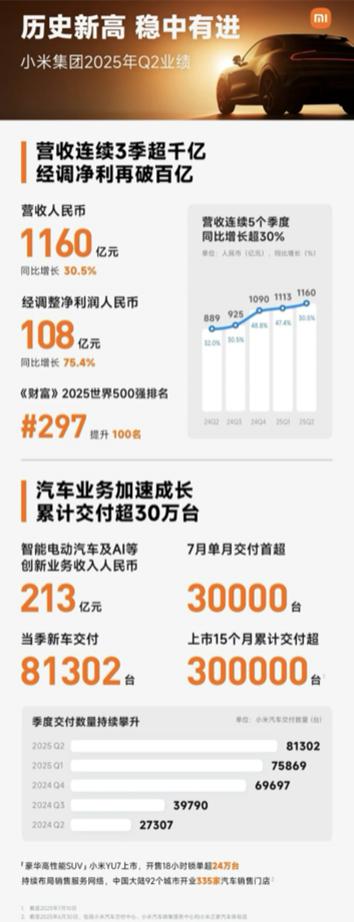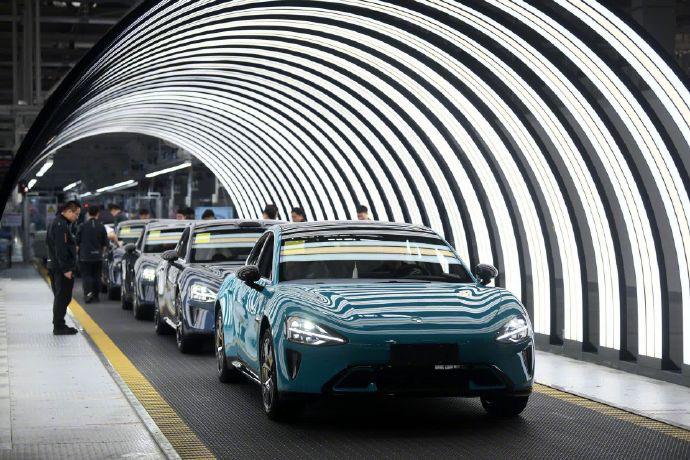Xiaomi Auto Business Just One Step Away From Profitability
Xiaomi's automotive business is just one step away from achieving single-quarter profitability, which has made the new EV startups still struggling in the mire of losses green with envy.
On the evening of August 19, Xiaomi Group officially released its financial report for the second quarter of 2025. This freshly released report features several highlights:
First, total revenue reached 116 billion yuan, and the company has achieved revenue exceeding 100 billion yuan for three consecutive quarters.
Second, net profit reached 10.8 billion yuan, achieving over 10 billion yuan in profit for two consecutive quarters.
3. Automotive business revenue reached 20.6 billion yuan, with losses significantly narrowed to 300 million yuan, and profitability expected in the second half of the year;
Fourth, the revenue from the mobile phone business, which serves as the foundation, has decreased, while the IoT (Internet of Things) and consumer lifestyle products business has seen significant growth.
R&D investment has increased to 7.8 billion yuan, setting a new historical high, with annual R&D investment expected to exceed 30 billion yuan.

The automotive business was "almost" profitable in a single quarter.
In terms of the automotive business alone, Xiaomi Auto delivered 81,300 new cars in the second quarter of this year, with revenue reaching 20.6 billion yuan and a gross profit margin of 26.4%. This translates to a gross profit of 67,000 yuan per vehicle. The loss narrowed from 500 million yuan in the first quarter of this year to 300 million yuan, improving by 40% quarter-over-quarter, which also makes Lei Jun's previous goal of "achieving profitability in the third or fourth quarter of 2025" seem increasingly realistic.
Xiaomi's ability to achieve both scale expansion and improved profitability in its automotive business hinges on two key factors: first, the scale effect of its main model, the SU7, is becoming evident, leading to significant optimization in procurement and manufacturing costs; second, the delivery of the SU7 Ultra has further optimized the product mix, raising the overall profitability level.

From the perspective of the per-vehicle "ledger," Xiaomi Auto's single-vehicle revenue in the second quarter increased from 228,600 yuan in the same period last year to 253,700 yuan, with allocated expenses of about 73,000 yuan, resulting in a net loss of only about 6,000 yuan. In the second quarter of this year, Xiaomi Auto's operating expenses amounted to 5.9 billion yuan. According to industry norms, as long as Xiaomi Auto can consistently deliver 30,000 to 35,000 new vehicles per month, the quarterly gross profit can reach around 6 billion yuan. At that point, keeping expenses within 6 billion yuan would make profitability achievable.
For Xiaomi Motors, the biggest challenge at present is production capacity and delivery. Previously, when the Xiaomi YU7 was released, it received 289,000 large orders within an hour, and now the backlog exceeds 200,000 orders. Xiaomi Group President Lu Weibing stated in the earnings call that the most important task at the moment is to deliver the orders as soon as possible. It is worth noting that the second phase of the Xiaomi Motors factory is nearing completion, and it is expected to achieve full-scale production soon, which will also ensure the achievement of Xiaomi Motors' annual sales target of 350,000 vehicles.

Certainly, the significant reduction in losses for Xiaomi's automotive business has also provided some insights for those emerging car companies that are still struggling for profitability.
For example, reasonably optimizing the product mix can increase overall gross profit margin and the value per vehicle. For emerging automakers, launching high-end models or increasing the proportion of high-end product sales can drive profit growth. For instance, in the second quarter of this year, XPeng Motors improved its gross profit margin by boosting sales of high-end models such as the updated G6, G9, and X9.
In addition, avoiding falling into a price war is also beneficial for companies to enter a healthy and virtuous cycle. During the conference call, Lu Weibing reiterated that Xiaomi Automobile firmly refuses to participate in “involution.” Currently, emerging carmakers are ushering in the “first year of large-scale profitability.” Aside from Xiaomi, companies like Li Auto and Leapmotor are collectively reaching a profitability inflection point thanks to rising delivery volumes rather than price competition. Therefore, emerging carmakers need to focus more on product delivery, quality improvement, and technological innovation in order to achieve profitability as soon as possible.
【Copyright and Disclaimer】The above information is collected and organized by PlastMatch. The copyright belongs to the original author. This article is reprinted for the purpose of providing more information, and it does not imply that PlastMatch endorses the views expressed in the article or guarantees its accuracy. If there are any errors in the source attribution or if your legitimate rights have been infringed, please contact us, and we will promptly correct or remove the content. If other media, websites, or individuals use the aforementioned content, they must clearly indicate the original source and origin of the work and assume legal responsibility on their own.
Most Popular
-

EVA Morning Prices on September 12: Most of the Market Holds Steady, Highest Rise of 50 Yuan
-

Domo Chemicals Files for Bankruptcy Protection in Germany! B. Braun Launches New Supply Assurance Program
-

Vynova's UK Chlor-Alkali Business Enters Bankruptcy Administration!
-

[PET Weekly Outlook] Polyester Bottle Chips Expected to Oscillate and Warm Up with Costs Today
-

Case Study | Clariant AddWorks™ Additives Solve Plastic Yellowing Problem






